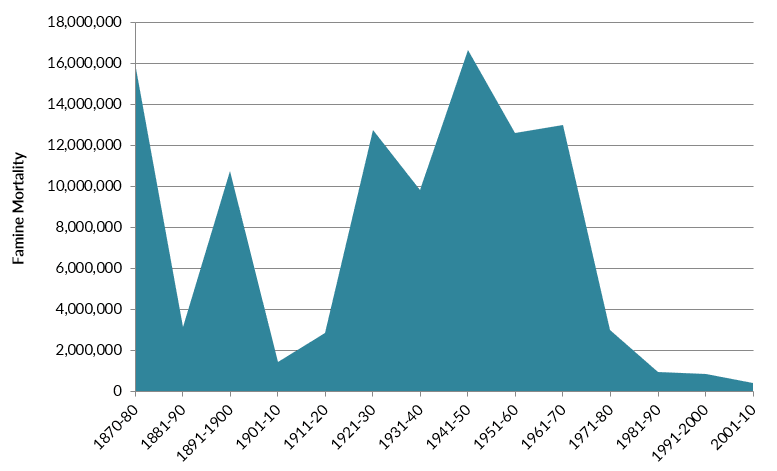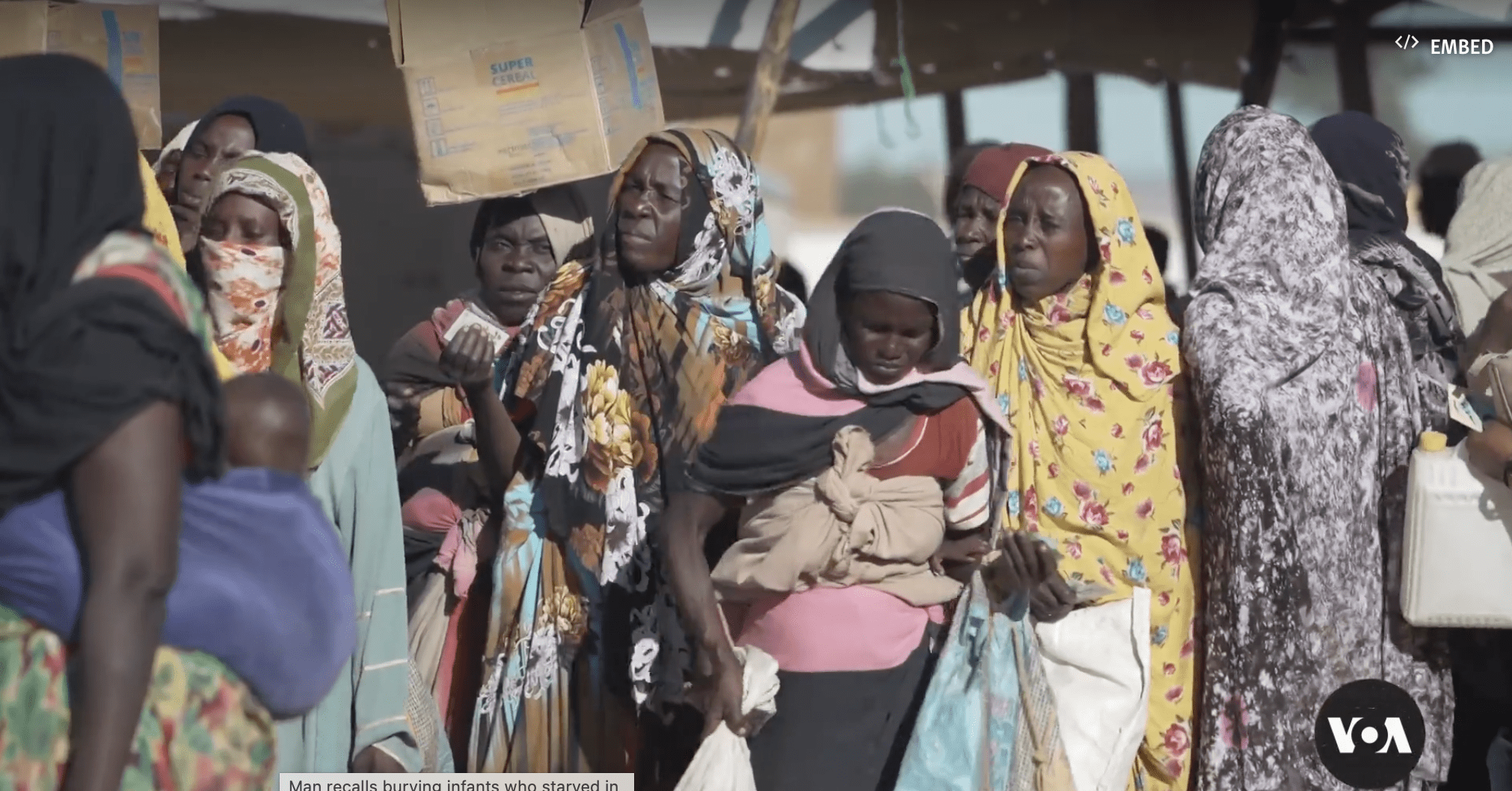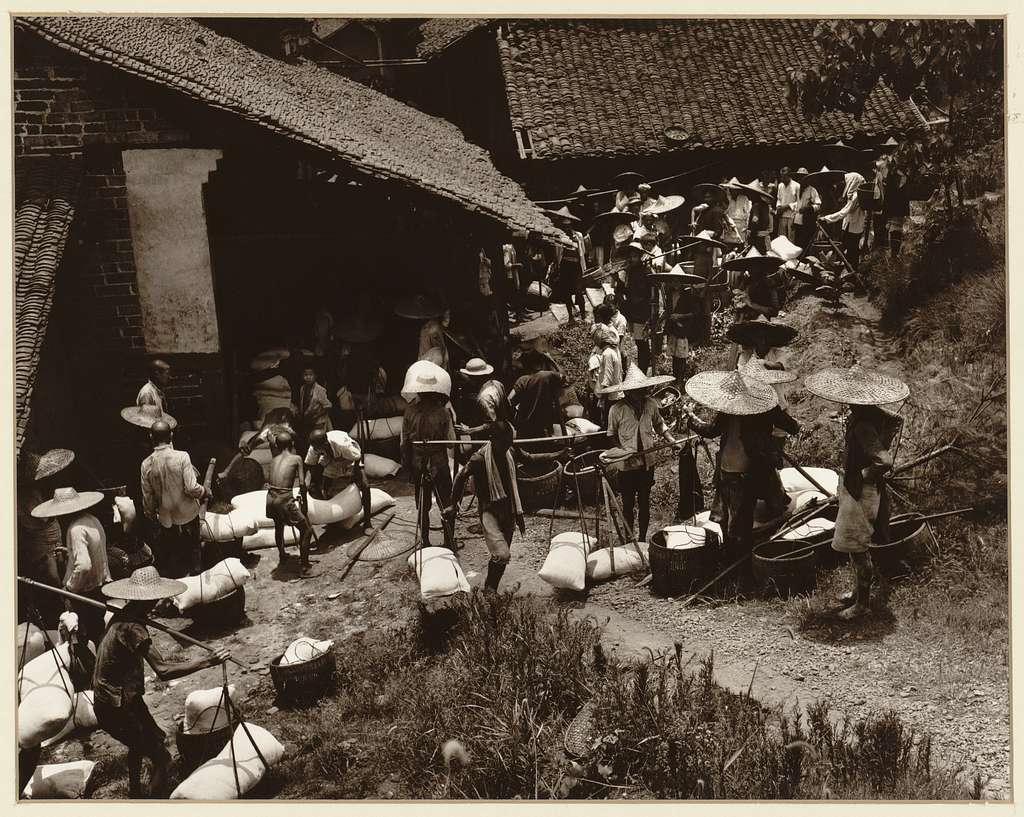This essay, by Batul Sadliwala and Alex de Waal, was originally printed by Migration Information Source, on November 15, 2018.
The synopsis taught in Irish schools of the demographic impact of the Great Hunger that devastated Ireland from 1845-52 is as follows: 1 million dead, 2 million emigrants. Is it a general rule that famines generate mass migration or was Ireland the exception? Remarkably, despite long-standing demographic research into famine and intensive current interest in migration, there is no definitive answer. But there is urgent policy interest in the link between mass starvation and migration. After decades in which famines had declined almost to vanishing point, 2017 and 2018 have witnessed their disturbing return, perhaps most starkly surrounding the war-induced starvation unfolding in Yemen. Meanwhile, Venezuela’s economic collapse and the government’s highly selective allocation of food and other essentials are causing unprecedented mass migration to the country’s Latin American neighbors, with reports of severe malnutrition and deaths from starvation.
This article examines the causes and migration patterns of episodes of mass starvation from the 19th century onward and demonstrates the critical need for deeper research on the linkages between famine and migration. Among the unanswered questions: Does migration mitigate starvation or worsen it? Does it precede or follow famine? And how?
Resurgence of an Age-Old Reality
The two global food insecurity and famine early-warning systems—the UN Food and Agriculture Organization (FAO) Global Early Warning-Early Action (EWEA) report and the Famine Early Warning Systems Network (FEWSNET)—sounded the alarm in 2017 and repeated it earlier this year. According to the FAO, six countries/regions were at a high risk of their food security and agriculture deteriorating to the point of an emergency. Of these, Yemen, South Sudan, and Somalia were described as facing the “risk of famine.”
In Somalia and Ethiopia’s Somali region, a prolonged drought combined with armed conflict threatens the collapse of agricultural production and livelihoods. Conflict and ensuing mass displacement have set conditions for widespread starvation in South Sudan and northeast Nigeria. And in Yemen, the economic war waged by Saudi Arabia and the United Arab Emirates to try to force the Houthi rebellion into surrender has brought the country to the brink of a disaster, described by UN Undersecretary General for Humanitarian Affairs and Emergency Relief Mark Lowcock as “an imminent and great big famine.”
According to FEWSNET, 53 percent of Yemen’s population—15 million people—need monthly emergency food assistance. To date, there have been 1 million cases of cholera and uncounted deaths from starvation. Moreover, as detailed in a recent report by London School of Economics Professor Martha Mundy on the Saudi-led coalition’s military strategy, there is strong evidence that the aerial bombardment of food-production and distribution facilities in areas under control of the Houthi opposition is deliberate.
The Changing Face of Famine
Famines are shape-shifters. In the pre-industrial era, agrarian societies were vulnerable to famine when crops failed. Imperial conquest and the devastations it wrought brought mass starvation to many colonized peoples. The wars of extermination of the mid-20th century and totalitarian rule in Europe and Asia engendered mass starvation through genocidal policies—Stalin’s Holodomor famine in Ukraine in 1932-34 and the Nazi Hunger plan on the Eastern Front in 1941-44 stand out as particularly terrible examples, each claiming millions of lives. Brutal efforts at titanic social transformation in Mao Zedong’s China killed somewhere between 25 million and 40 million, while in Pol Pot’s Cambodia more than 1 million perished.
In total, famines and episodes of forcible mass starvation have killed more than 104 million people worldwide since 1870, with an estimated 30 million dying from great famines in the last three decades of the 19th century and 74 million during the 20th century, according to estimates recorded by the World Peace Foundation’s Famine Trends Dataset.
Famine in the 21st Century
By comparison, the complex emergencies in contemporary Africa are demographically much less devastating affairs, their effects mitigated by increasingly proficient humanitarian relief efforts. By the early 2000s, scholars of famine were predicting that their subject matter was fast becoming consigned to history. But in the last two years, famine has made a comeback.
As famine makes an unsettling return, the global spotlight on migration nods to its potential implications for population displacement and migration governance. The final text of the Global Compact for Safe, Orderly, and Regular Migration due to be approved by most UN Member States in December acknowledges food insecurity both as one of several adverse drivers of migration whose effects need to be minimized (Objective 2.b) and as a rights violation to be avoided during migrants’ detention (Objective 13.f). Yet famines—food crises that cause elevated mortality over a specific period of time—are distinct from the food insecurity and hunger characterized by underdevelopment. The Global Compact’s perfunctory mention of food insecurity belies the fact that surprisingly little is known about the connection between acute food crises and population mobility. If famines are indeed making a return, this is a critically important question for policymakers.
The State of Current Research
Which people most likely to migrate during a famine? Where do they go and for how long? Does migration mitigate starvation or worsen it? What factors determine its effectiveness as an escape? And how do conflict, politics, and political instability complicate the relationship between famine and population movements? To pose the question within a more concrete context: with the ongoing war in Yemen, for instance, what might be the humanitarian and development implications of famine-induced migration for the Middle East and Europe?
A systematic review of the relevant literature reveals that we are frighteningly ill-equipped to answer these questions. A Google Scholar search for the terms “famine” AND “migration” yields around 150,000 results. But a closer look at the quality of those results reveals only a handful are relevant to the subject. Tellingly, when the search is focused on databases of peer-reviewed publications and its parameters narrowed to home in on clear and specific examinations of the connection between famine and migration, just 35 articles, books, and chapters (8 percent of overall results) make the cut. And even among these, the variability in methods and scope is so vast that only the most tenuous of generalizations can be made. Scholars are overwhelmingly focused on the impact famine has on mortality, fertility, and refugee assistance, and not the how, when, who, and so what of the famine-migration nexus.
Most writing on the demographic and socioeconomic consequences of famine makes the commonsensical assumption that hunger compels people to leave their homes, villages, and towns. But the conclusions are far too broad and generalized to be of practical relevance for policymakers or humanitarian practitioners. Leading authorities on famine including David Arnold, Tim Dyson, and Cormac Ó Gráda only go so far as to say that migration:
- Is both a response to and an indicator of famine; modern improvements in transport and communications have potentially increased its viability as a means of escape from starvation
- Is mostly short-term and local (to urban areas)
- Can have either positive or negative net mortality effects—the latter by adding to physical weakness conducive for the transmission of communicable diseases—but as economies have diversified and transportation improved, it likely has a beneficial effect overall
- Is age and sex-selective. Conventional wisdom assumes young men, seen as less vulnerable on the road, are more likely to migrate and seek employment or aid elsewhere, while women remain to care for the home.
However, a literature review by the authors of this article shows that these generalizations are not based on an inductive comparison of findings across a wide range of cases. The current state of research does not allow them to be. Just a handful of historical famines and their migratory dynamics—most notably Ireland and some other 19thcentury European and South Asian famines—have been studied with significantly more rigor than others. And these studies’ findings do not always correspond to the points above. Famines and their patterns of migration depend upon the specific socioeconomic context, levels of infrastructure and technology, and the decisions of political and military leaders. War-famines are conspicuously under-researched—but these are the most common kind faced today. The lack of uniform and systematic research across cases at the aggregate level is thus compounded by the complexity of socioeconomic and political forces shaping the famine-migration nexus.
The Irish and Other Famine Migrations
Undoubtedly the most well documented and extensively researched case of a famine migration is that of the Great Irish Famine. The emigration of 2 million Irish between 1845-52 was predominantly long distance (to the United States and Canada) and permanent. Social and economic historians and demographers have researched this calamity in unparalleled detail. They ask why some Irish counties experienced greater levels of outmigration than others, what the trans-Atlantic passage to America was like, how did family and friends abroad facilitate mobility, and whether political authorities could have done more to facilitate migration as a form of relief.
Studies of other cases are sparser or deal with narrow aspects of the famine-migration nexus. India is blessed with exceptionally good population statistics dating back to the mid-19th century, making it a favorite focus for demographic research. Data on migration during famines such as Bombay (1876-78), Madras (1877-78), and Punjab (1896-97), are used to answer questions about the number of people killed by disease or hunger and about the effect on fertility. But with the exception of Christopher Hill’s study of British famine policy in colonial north India and its effect on peasants’ migration, scholars have paid next to no attention to the kinds of questions asked in the Irish case. Meanwhile, handicapped by poor data and mostly reliant on village-level studies, most research into African food crises focuses on questions of household livelihoods.
Politics is the often-missing link in the research agenda. Government policies are often to blame for creating or exacerbating famines, and are also the determining factor in what kind of migration is feasible. Thus, the lack of political support for publicly assisted emigration during the Great Irish Famine’s worst years—a dearth partially fueled by anti-Irish prejudice in Britain—meant that the most vulnerable were the least able to escape. And during the 1867-69 famine in the present-day Estonia, the regional government in fact increased restrictions on peasants’ mobility because population movement was not in landowners’ best interests. Turning to the more recent case of the Ethiopian famine of 1983-85, forced population transfers under the guise of food relief were a key feature of the counterinsurgency strategy of the military regime against rebels in the northern provinces of Tigray and Wollo. This state-led restrictive management of mobility did little to alleviate starvation while some external donors’ relief efforts unwittingly abetted forced resettlement. From the authors’ review, the politics of famine migration is however the least deliberately and uniformly studied aspect of the issue.
Different Patterns of Migration
Patterns of famine-related migration are even more complex than these cases imply. The different causal sequences that lead to famine also contribute to different patterns of migration. The mobility of the hungry is influenced strongly by the structure of rural livelihoods and varies according to the causes of the famine. For instance, places subject to recurrent food insecurity and famine, such as Sudan and the West African Sahel, have witnessed long-term trends of migration away from ecologically marginal areas on the desert edge to more productive areas further south, and from rural areas to cities. Such movements are not always limited by state borders, and communities and individuals also migrate transnationally in search of sustainable livelihoods. Literature on the Sahelian famine of the 1970s and among the pastoralist Afar and Somali of Ethiopia details how sedenterization of formerly nomadic peoples—a change in movement patterns rather than migration—resulted in the deprivation of a traditionally autonomous society. For the Gogo of Tanzania, colonial polices such as labor conscription stripped traditional agrarian societies of their autonomous ability to deal with the risk of food shortages.
Modern-day, state-led counterinsurgency strategies also act as drivers of displacement and traumatizing accelerants of urbanization. Military strategies selectively inflict hunger, whether deliberately or as collateral damage, through the control of food and other humanitarian aid. In Yemen, Mundy’s analysis of Saudi coalition attacks since March 2015 finds a systematic shift away from military targets towards economic ones, including farms, which cover less than 3 percent of the country’s land surface. Between March 2015 and August 2016, farms followed by livestock were the most frequent agricultural targets, with Sa’da governate—the Houthis’ home base—being most severely hit. Combine this with blockades of the main port at Al-Hudayda (which receives the bulk of humanitarian and commercial shipments), the sealing-off of Sanaa airport, and relocation of the central bank to Aden (which means government employees in areas controlled by the rebels no longer get paid), and a clear strategy to starve into submission emerges. Sometimes hunger is used as a weapon to force people to flee (as in South Sudan today), sometimes to keep them in place to force them to surrender (as in the besieged enclaves of Syria, or the militant-held areas of northeastern Nigeria), or a combination of the two (as in Yemen today). However, although this topic is generating media coverage and bouts of public angst, the academy—limited by its disciplinary silos—has yet to devote sustained attention to the famine-migration nexus. As in the case of other pressing issues, famine demographers, analysts of rural livelihoods, migration specialists, and scholars of conflict struggle to meaningfully acknowledge and integrate one another’s work into their own.
A Pressing Need for an Evidence-Based Humanitarian and Policy Response
Not nearly enough is known about the intersection of famine and migration. One can predict that it is fast becoming a pressing humanitarian and political concern. Furthermore, it is increasingly clear that the narrow and often managerial treatment of food insecurity as an adverse driver of migration within global development and humanitarian policy fails to address the key political aspects of modern famines and related mass-distress migration. The understanding of contemporary famine has shifted from a focus on food availability or access to politics and policies. Work by (among others) Stephen Devereux, David Keen, and Alex de Waal shows that disruptions in food supply or access, climate change, and natural disasters are themselves insufficient conditions for a famine to occur. Famines strike when a political decision, by way of an act of commission or omission, creates one (see Figure 2). Migration—whether voluntary or forced, internal or international—is likewise shaped by the political context within which it occurs.
Source: World Peace Foundation, Tufts University
The international regimes for responding to famine and to forced migration are ill-matched. The standard relief program regards those who have migrated from hunger as short-term displaced people in need of food and shelter until they can return home when matters improve. Relief workers do not see their job as assisting in longer-term processes of urbanization or outmigration, and still less are they equipped to deal with the political causes of starvation. This may be starting to change: UN Security Council Resolution 2417, adopted in May 2018, condemns the use of starvation of civilians as an unlawful war tactic. Meanwhile, a classical understanding of the 1951 Refugee Convention would not yield a sympathetic outcome for persons fleeing famine or food deprivation, especially if the politics which determine who starves and who must flee are not acknowledged by the international community, specifically host governments and the UN High Commissioner for Refugees (UNHCR). If climate change contributes to food crises and distress migration—and also fuels the malign and xenophobic politics that worsen these two problems—governments may find their legal and policy tools even more poorly suited to the challenges ahead.
Review of what is known—and what must be known—about the famine-migration nexus turns up an astonishing scarcity of rigorous scholarly research in this field. As famines appear again, one can only conclude with a cri de coeur: This is an urgent topic about which we know far too little.
Sources
Arnold, David. 1988. Famine: Social Crisis and Historical Change: New Perspectives on the Past. New York, NY: Blackwell, 1988.
Berhanu, Betemariam and Michael White. 2000. War, Famine, and Female Migration in Ethiopia, 1960–1989. Economic Development and Cultural Change 49 (1): 91–113.
Clark, Andrew F. 1994. Internal Migrations and Population Movements in the Upper Senegal Valley (West Africa), 1890-1920. Canadian Journal of African Studies / Revue Canadienne Des Études Africaines 28 (3): 399–420.
Cousens, S. H. 1960. The Regional Pattern of Emigration during the Great Irish Famine, 1846-51. Transactions and Papers (Institute of British Geographers), no. 28: 119–34. Available online.
Davies, Susanna. 1996. Adaptable Livelihoods: Coping with Food Insecurity in the Malian Sahel. London: Palgrave Macmillan, 1996.
de Waal, Alex. 2005. Famine That Kills: Darfur, Sudan, revised edition. Oxford, UK: Oxford University Press.
—. 2017. Mass Starvation: The History and Future of Famine. Cambridge, UK and Medford, MA: Polity Press.
Devereux, Stephen, ed. 2007. The New Famines: Why Famines Persist in an Era of Globalization. New York: Routledge.
Duffield, Mark. 2014. Global Governance and the New Wars: The Merging of Development and Security. New York: Zed Books Ltd.
Dyson, Tim and Cormac Ó Gráda, eds. 2002. Famine Demography: Perspectives from the Past and Present. Oxford, UK: Oxford University Press.
Famine Early Warning Systems Network (FEWSNET). 2018. Acute Food Insecurity: Near Term (September 2018). Available online.
—. 2018. Yemen Food Security Alert. October 24, 2018. Available online.
Food and Agriculture Organization (FAO). 2017. Global Early Warning – Early Action Report on Food Security and Agriculture, January – March 2017. Available online.
—. 2018. FAO and IOM Boost Cooperation on Migration. FAO news article, January 24, 2018. Available online.
—. 2018. Global Early Warning – Early Action Report on Food Security and Agriculture, January – March 2018. Available online.
Global Compact for Safe, Orderly and Regular Migration – Final Draft (11 July 2018). 2018. Available online.
Gray, Peter. 1999. ‘Shovelling out Your Paupers’: The British State and Irish Famine Migration 1846-50. Patterns of Prejudice 33 (4): 47–65.
Hammond, Laura. 2011. Governmentality in Motion: 25 Years of Ethiopia’s Experience of Famine and Migration Policy. Mobilities 6 (3): 415–32.
Hathaway, James C. 2014. Food Deprivation: A Basis for Refugee Status? Social Research; New York 81 (2): 327-39, 501.
Hill, Christopher V. 1991. Philosophy and Reality in Riparian South Asia: British Famine Policy and Migration in Colonial North India. Modern Asian Studies 25 (2): 263–79.
Hugo, Graeme. 2013. Famine and Migration. In The Encyclopedia of Global Human Migration, ed. Immanuel Ness. Oxford, UK: Blackwell Publishing Ltd.
Keen, David. 2008. The Benefits of Famine: A Political Economy of Famine and Relief in Southwestern Sudan, 1983-1989. Rochester: Boydell and Brewer (James Currey).
Lowcock, Mark. 2018. Remarks of the Under Secretary General for Humanitarian Affairs and Emergency Relief Coordinator to the Security Council on the Humanitarian Situation in Yemen. October 23, 2018. Available online.
Lust, Kersti. 2015. Providing for the Hungry? Famine Relief in the Russian Baltic Province of Estland, 1867–9. Social History 40 (1): 15–37.
Maddox, Gregory H. 1991. Famine, Impoverishment and the Creation of a Labor Reserve in Central Tanzania. Disasters 15 (1): 35–42.
Maharatna, Arup. 1994. Regional Variation in Demographic Consequences of Famines in Late 19th and Early 20th Century India. Economic and Political Weekly 29 (23): 1399–1410.
—. 2014. Food Scarcity and Migration: An Overview. Social Research: An International Quarterly 81 (2): 277–98.
Mulrooney, Margaret M. 2003. The Ties That Bind: The Family Networks of Famine Refugees at the DePont Powder Mills 1802-1902. In Fleeing the Famine: North America and Irish Refugees, 1845-1851, ed. Margaret M. Mulrooney. Westport, CT: Praeger.
Mundy, Martha. 2018. The Strategies of the Coalition in The Yemen War: Aerial Bombardment and Food War. Medford, MA: Tufts University, World Peace Foundation. Available online.
Ó Gráda, Cormac. 2009. Famine: A Short History. Princeton, NJ: Princeton University Press.
Ó Gráda, Cormac and Kevin H. O’Rourke. 1997. Migration as Disaster Relief: Lessons from the Great Irish Famine. European Review of Economic History 1 (1): 3–25.
Pitkänen, Kari J. 1992. The Road to Survival or Death? Temporary Migration during the Great Finnish Famine in the 1860s. In Just a Sack of Potatoes? Crisis Experiences in European Societies, Past and Present, ed. Antti Häkkinen.
Spray, William. 2003. Irish Famine Migration and the Passage Trade to North America. In Fleeing the Famine: North America and Irish Refugees, 1845-1851, ed. Margaret M. Mulrooney. Westport, CT: Praeger.
Swift, Jeremy. 1977. Sahelian Pastoralists: Underdevelopment, Desertification, and Famine. Annual Review of Anthropology 6: 457-58.
UN Security Council. 2018. Adopting Resolution 2417 (2018), Security Council Strongly Condemns Starving of Civilians, Unlawfully Denying Humanitarian Access as Warfare Tactics. Meetings coverage, May 24, 2018. Available online.
Watts, Michael. 1983. Silent Violence: Food, Famine, & Peasantry in Northern Nigeria. Berkeley, CA: University of California Press.
Whitcombe, Elizabeth. 1993. Famine Mortality. Economic and Political Weekly 28 (23): 1169–79.
Young, Helen, Karen Jacobsen, and Abdul Monium Osman. 2009. Livelihoods, Migration and Conflict: Discussion of Findings from Two Studies in West and North Darfur, 2006 – 2007. Medford, MA: Tufts University, Feinstein International Center. Available online.





